Glucose Biosensor Based on Disposable Activated Carbon Electrodes Modified with Platinum Nanoparticles Electrodeposited on Poly(Azure A)
Abstract
1. Introduction
2. Materials and Methods
2.1. Chemicals and Solutions
2.2. Preparation of Modified Electrodes
- (1)
- Activation of SPCEs: Commercial SPCEs were activated by performing 12 repetitive cyclic voltammograms between 1 and −1 V in 10 mM H2O2 in 0.1 M of phosphate buffer (PB) with pH 7 at 10 mV∙s−1. Once activated, the electrodes (aSPCEs) were rinsed with deionized water and dried in air. It is noteworthy that this protocol has been improved with respect to our previously published work [25], but here, we obtained a similar electrochemical outcome and sensitivity towards H2O2 oxidation, with a significant reduction of 1 h in the activation time.
- (2)
- Electropolymerization of azure A: PAA was electrodeposited on the working electrode surface of aSPCEs following the protocol described in the literature [19].
- (3)
- PtNPs electrosynthesis: Platinum nanoparticles were electrogenerated by chronoamperometry at −0.4 V for 900 s in a solution 0.2% H2PtCl6, as indicated in the literature [18]. The resulting electrodes (PtNPs-PAA-aSPCEs) were rinsed with deionized water, dried, and stored until use.
- (4)
- Glucose oxidase immobilization: 10 µL of an enzyme solution at the indicated concentration in 0.05 M of PB, with pH 7, was drop-cast onto the modified surface of the working electrode for a certain time. When the immobilization time was finished, the remaining solution was removed, and the electrodes were first rinsed with deionized water several times and finally with 0.1 M of PB with pH 7. The electrochemical glucose biosensor was named GOx-PtNPs-PAA-aSPCE.
2.3. Electrochemical Measurements
2.4. Physicochemical Measurements
3. Results
3.1. Characterization and Optimization of the Electrochemical Performance of the Glucose Biosensor
3.2. Analytical Performance of the Glucose Biosensor
4. Conclusions
Supplementary Materials
Author Contributions
Funding
Conflicts of Interest
References
- Heller, A.; Feldman, B. Electrochemical glucose sensors and their applications in diabetes management. Chem. Rev. 2008, 108, 2482–2505. [Google Scholar] [CrossRef] [PubMed]
- Samphao, A.; Butmee, P.; Jitcharoen, J.; Svorc, L.U.; Raber, G.; Kalcher, K. Flow-injection amperometric determination of glucose using a biosensor based on immobilization of glucose oxidase onto Au seeds decorated on core Fe3O4 nanoparticles. Talanta 2015, 142, 35–42. [Google Scholar] [CrossRef]
- Watla-Iad, K.; Sakai, T.; Teshima, N.; Katoh, S.; Grudpan, K. Successive determination of urinary protein and glucose using spectrophotometric sequential injection method. Anal. Chim. Acta 2007, 604, 139–146. [Google Scholar] [CrossRef]
- Wilson, A.M.; Work, T.M.; Bushway, A.A.; Bushway, R.J. HPLC determination of fructose, glucose, and sucrose in potatoes. J. Food Sci. 1981, 46, 300–301. [Google Scholar] [CrossRef]
- Wang, X.Y.; Chen, Y.; Li, Z.; Wang, Z. Analysis of carbohydrates by capillary zone electrophoresis with on-capillary derivatization. J. Liq. Chromatogr. Related Technol. 2002, 25, 589–600. [Google Scholar] [CrossRef]
- Heise, H.M.; Marbach, R.; Janatsch, G.; Krusejarres, J.D. Multivariate determination of glucose in whole-blood by attenuated total reflection infrared-spectroscopy. Anal. Chem. 1989, 61, 2009–2015. [Google Scholar] [CrossRef]
- Russell, R.J.; Pishko, M.V.; Gefrides, C.C.; McShane, M.J.; Cote, G.L. A fluorescence-based glucose biosensor using concanavalin A and dextran encapsulated in a poly(ethylene glycol) hydrogel. Anal. Chem. 1999, 71, 3126–3132. [Google Scholar] [CrossRef] [PubMed]
- Wang, J. Electrochemical Glucose Biosensors. Chem. Rev. 2008, 108, 814–825. [Google Scholar] [CrossRef]
- Nguyen, H.H.; Lee, S.H.; Lee, U.J.; Fermin, C.D.; Kim, M. Immobilized enzymes in biosensor applications. Materials 2019, 12, 121. [Google Scholar] [CrossRef]
- Chen, C.; Xie, Q.J.; Yang, D.W.; Xiao, H.L.; Fu, Y.C.; Tan, Y.M.; Yao, S.Z. Recent advances in electrochemical glucose biosensors: A review. RSC Adv. 2013, 3, 4473–4491. [Google Scholar] [CrossRef]
- Ang, L.F.; Por, L.Y.; Yam, M.F. Development of an amperometric-based glucose biosensor to measure the glucose content of fruit. PLoS ONE 2015, 10, 111859. [Google Scholar] [CrossRef] [PubMed]
- Amor-Gutiérrez, O.; Rama, E.C.; Fernández-Abedul, M.T.; Costa-García, A. Bioelectroanalysis in a drop: Construction of a glucose biosensor. J. Chem. Educ. 2017, 94, 806–812. [Google Scholar] [CrossRef]
- Yang, T.-H.; Hung, C.-L.; Ke, J.-H.; Zen, J.-M. An electrochemically preanodized screen-printed carbon electrode for achieving direct electron transfer to glucose oxidase. Electrochem. Commun. 2008, 10, 1094–1097. [Google Scholar] [CrossRef]
- Sanzo, G.; Taurino, I.; Puppo, F.; Antiochia, R.; Gorton, L.; Favero, G.; Mazzei, F.; Carrara, S.; De Micheli, G. A bimetallic nanocoral Au decorated with Pt nanoflowers (bio)sensor for H2O2 detection at low potential. Methods 2017, 129, 89–95. [Google Scholar] [CrossRef]
- Yang, H.; Gong, C.; Miao, L.; Xu, F. A Glucose biosensor based on horseradish peroxidase and glucose oxidase co-entrapped in carbon nanotubes modified electrode. Int. J. Electrochem. Sci. 2017, 12, 4958–4969. [Google Scholar] [CrossRef]
- Raicopol, M.; Pruna, A.; Damian, C.; Pilan, L. Functionalized single-walled carbon nanotubes/polypyrrole composites for amperometric glucose biosensors. Nanoscale Res. Lett. 2013, 8, 1–8. [Google Scholar] [CrossRef] [PubMed]
- Tang, H.; Chen, J.H.; Yao, S.Z.; Nie, L.H.; Deng, G.H.; Kuang, Y.F. Amperometric glucose biosensor based on adsorption of glucose oxidase at platinum nanoparticle-modified carbon nanotube electrode. Anal. Biochem. 2004, 331, 89–97. [Google Scholar] [CrossRef]
- Agrisuelas, J.; González-Sánchez, M.I.; Valero, E. Hydrogen peroxide sensor based on in situ grown Pt nanoparticles from waste screen-printed electrodes. Sens. Actuators B Chem. 2017, 249, 499–505. [Google Scholar] [CrossRef]
- Agrisuelas, J.; González-Sánchez, M.I.; Valero, E. Electrochemical properties of poly(azure A) films synthesized in sodium dodecyl sulfate solution. J. Electrochem. Soc. 2017, 164, G1. [Google Scholar] [CrossRef]
- Liu, T.; Luo, Y.; Zhu, J.; Kong, L.; Wang, W.; Tan, L. Non-enzymatic detection of glucose using poly(azure A)-nickel. Talanta 2016, 156, 134–140. [Google Scholar] [CrossRef]
- Liu, T.; Guo, Y.; Zhang, Z.; Miao, Z.; Zhang, X.; Su, Z. Fabrication of hollow CuO/PANI hybrid nanofibers for non-enzymatic electrochemical detection of H2O2 and glucose. Sens. Actuators B Chem. 2019, 286, 370–376. [Google Scholar] [CrossRef]
- Turkmen, E.; Bas, S.Z.; Gulce, H.; Yildiz, S. Glucose biosensor based on immobilization of glucose oxidase in electropolymerized poly(o-phenylenediamine) film on platinum nanoparticles-polyvinylferrocenium modified electrode. Electrochim. Acta 2014, 123, 93–102. [Google Scholar] [CrossRef]
- Zhai, D.; Liu, B.; Shi, Y.; Pan, L.; Wang, Y.; Li, W.; Zhang, R.; Yu, G. Highly sensitive glucose sensor based on Pt nanoparticle/polyaniline hydrogel heterostructures. ACS Nano 2013, 7, 3540–3546. [Google Scholar] [CrossRef] [PubMed]
- Mazeiko, V.; Kausaite-Minkstimiene, A.; Ramanaviciene, A.; Balevicius, Z.; Ramanavicius, A. Gold nanoparticle and conducting polymer-polyaniline-based nanocomposites for glucose biosensor design. Sens. Actuators B Chem. 2013, 189, 187–193. [Google Scholar] [CrossRef]
- González-Sánchez, M.I.; Gómez-Monedero, B.; Agrisuelas, J.; Iniesta, J.; Valero, E. Highly activated screen-printed carbon electrode by electrochemical treatment with hydrogen peroxide. Electrochem. Commun. 2018, 91, 36–40. [Google Scholar] [CrossRef]
- González-Sánchez, M.I.; Gómez-Monedero, B.; Agrisuelas, J.; Iniesta, J.; Valero, E. Electrochemical performance of activated screen-printed carbon electrodes for hydrogen peroxide and phenol derivatives sensing. J. Electroanal. Chem. 2019, 839, 75–82. [Google Scholar] [CrossRef]
- Agrisuelas, J.; González-Sánchez, M.I.; Gómez-Monedero, B.; Valero, E. A comparative study of poly(azure A) film-modified disposable electrodes for electrocatalytic oxidation of H2O2. Effect of doping anion. Polymers 2018, 10, 48. [Google Scholar] [CrossRef]
- Gómez-Monedero, B.; González-Sánchez, M.-I.; Iniesta, J.; Agrisuelas, J.; Valero, E. Design and characterization of effective Ag, Pt and AgPt nanoparticles to H2O2 electrosensing from scrapped printed electrodes. Sensors 2019, 19, 1685. [Google Scholar] [CrossRef]
- Jiménez-Pérez, R.; González-Rodriguez, J.; González-Sánchez, M.I.; Gómez-Monedero, B.; Valero, E. Highly sensitive H2O2 sensor based on poly(azure A)-platinum nanoparticles deposited on activated screen printed carbon electrodes. Sens. Actuators B Chem. 2019, 298, 126878. [Google Scholar] [CrossRef]
- Jiménez-Pérez, R.; Almagro, L.; González-Sánchez, M.I.; Pedreño, M.A.; Valero, E. Non-enzymatic screen-printed sensor based on PtNPs@polyazure A for the real-time tracking of the H2O2 secreted from living plant cells. Bioelectrochemistry 2020, 134, 107526. [Google Scholar] [CrossRef]
- Gamborg, O.L.; Larue, T.A.G. Ethylene produced by plant cells in suspension cultures. Nature 1968, 220, 604–605. [Google Scholar] [CrossRef] [PubMed]
- Mergel, O.; Gelissen, A.P.H.; Wuennemann, P.; Boeker, A.; Simon, U.; Plamper, F.A. Selective packaging of ferricyanide within thermoresponsive microgels. J. Phys. Chem. C 2014, 118, 26199–26211. [Google Scholar] [CrossRef]
- Manoj, D.; Theyagarajan, K.; Saravanakumar, D.; Senthilkumar, S.; Thenmozhi, K. Aldehyde functionalized ionic liquid on electrochemically reduced graphene oxide as a versatile platform for covalent immobilization of biomolecules and biosensing. Biosens. Bioelectron. 2018, 103, 104–112. [Google Scholar] [CrossRef] [PubMed]
- Brugnerotto, P.; Silva, T.R.; Brondani, D.; Zapp, E.; Vieira, I.C. Gold nanoparticles stabilized in β-cyclodextrin and decorated with laccase applied in the construction of a biosensor for rutin. Electroanalysis 2017, 29, 1031–1037. [Google Scholar] [CrossRef]
- Hossain, M.F.; Park, J.Y. Fabrication of sensitive enzymatic biosensor based on multi-layered reduced graphene oxide added PtAu nanoparticles-modified hybrid electrode. PLoS ONE 2017, 12, 173553. [Google Scholar] [CrossRef]
- Retama, J.R.; López-Ruiz, B.; López-Cabarcos, E. Microstructural modifications induced by the entrapped gulcose oxidase in cross-linked polyacrylamide microgels used as glucose sensors. Biomaterials 2003, 24, 2965–2973. [Google Scholar] [CrossRef]
- Phetsang, S.; Jakmunee, J.; Mungkornasawakul, P.; Laocharoensuk, R.; Ounnunkad, K. Sensitive amperometric biosensors for detection of glucose and cholesterol using a platinum/reduced graphene oxide/poly(3-aminobenzoic acid) film-modified screen-printed carbon electrode. Bioelectrochemistry 2019, 127, 125–135. [Google Scholar] [CrossRef]
- Vukojevic, V.; Djurdjic, S.; Ognjanovic, M.; Fabian, M.; Samphao, A.; Kalcher, K.; Stankovic, D.M. Enzymatic glucose biosensor based on manganese dioxide nanoparticles decorated on graphene nanoribbons. J. Electroanal. Chem. 2018, 823, 610–616. [Google Scholar] [CrossRef]
- Mazzotta, E.; Rella, S.; Turco, A.; Malitesta, C. XPS in development of chemical sensors. RSC Adv. 2015, 5, 83164–83186. [Google Scholar] [CrossRef]
- Zhang, G. Surface modified electrodes in a microfluidic biosensor. In Nanoscale Surface Modification for Enhanced Biosensing: A Journey toward Better Glucose Monitoring; Springer International Publishing: Cham, Switzerland, 2015. [Google Scholar]
- Zhong, H.; Yuan, R.; Chai, Y.; Li, W.; Zhong, X.; Zhang, Y. In situ chemo-synthesized multi-wall carbon nanotube-conductive polyaniline nanocomposites: Characterization and application for a glucose amperometric biosensor. Talanta 2011, 85, 104–111. [Google Scholar] [CrossRef]
- González-Sánchez, M.I.; Rubio-Retama, J.; López-Cabarcos, E.; Valero, E. Development of an acetaminophen amperometric biosensor based on peroxidase entrapped in polyacrylamide microgels. Biosen. Bioelectron. 2011, 26, 1883–1889. [Google Scholar] [CrossRef] [PubMed]
- Gouda, M.D.; Kumar, M.A.; Thakur, M.S.; Karanth, N.G. Enhancement of operational stability of an enzyme biosensor for glucose and sucrose using protein based stabilizing agents. Biosens. Bioelectron. 2002, 17, 503–507. [Google Scholar] [CrossRef]
- González-Sánchez, M.I.; Agrisuelas, J.; Valero, E.; Compton, R.G. Measurement of total antioxidant capacity by electrogenerated iodine at disposable screen printed electrodes. Electroanalysis 2017, 29, 1316–1323. [Google Scholar] [CrossRef]
- Al-Sagur, H.; Kaya, E.N.; Durmus, M.; Basova, T.V.; Hassan, A. Amperometric glucose biosensing performance of a novel graphene nanoplatelets-iron phthalocyanine incorporated conducting hydrogel. Biosens. Bioelectron. 2019, 139, 111323. [Google Scholar] [CrossRef] [PubMed]
- Akhtar, M.A.; Batool, R.; Hayat, A.; Han, D.; Riaz, S.; Khan, S.U.; Nasir, M.; Nawaz, M.H.; Niu, L. Functionalized graphene oxide bridging between enzyme and Au-sputtered screen-printed interface for glucose detection. ACS Appl. Nano Mater. 2019, 2, 1589–1596. [Google Scholar] [CrossRef]
- Amor-Gutierrez, O.; Rama, E.C.; Costa-García, A.; Fernández-Abedul, M.T. Paper-based maskless enzymatic sensor for glucose determination combining ink and wire electrodes. Biosens. Bioelectron. 2017, 93, 40–45. [Google Scholar] [CrossRef]
- Kong, F.-Y.; Gu, S.-X.; Li, W.-W.; Chen, T.-T.; Xu, Q.; Wang, W. A paper disk equipped with graphene/polyaniline/Au nanoparticles/glucose oxidase biocomposite modified screen-printed electrode: Toward whole blood glucose determination. Biosens. Bioelectron. 2014, 56, 77–82. [Google Scholar] [CrossRef]
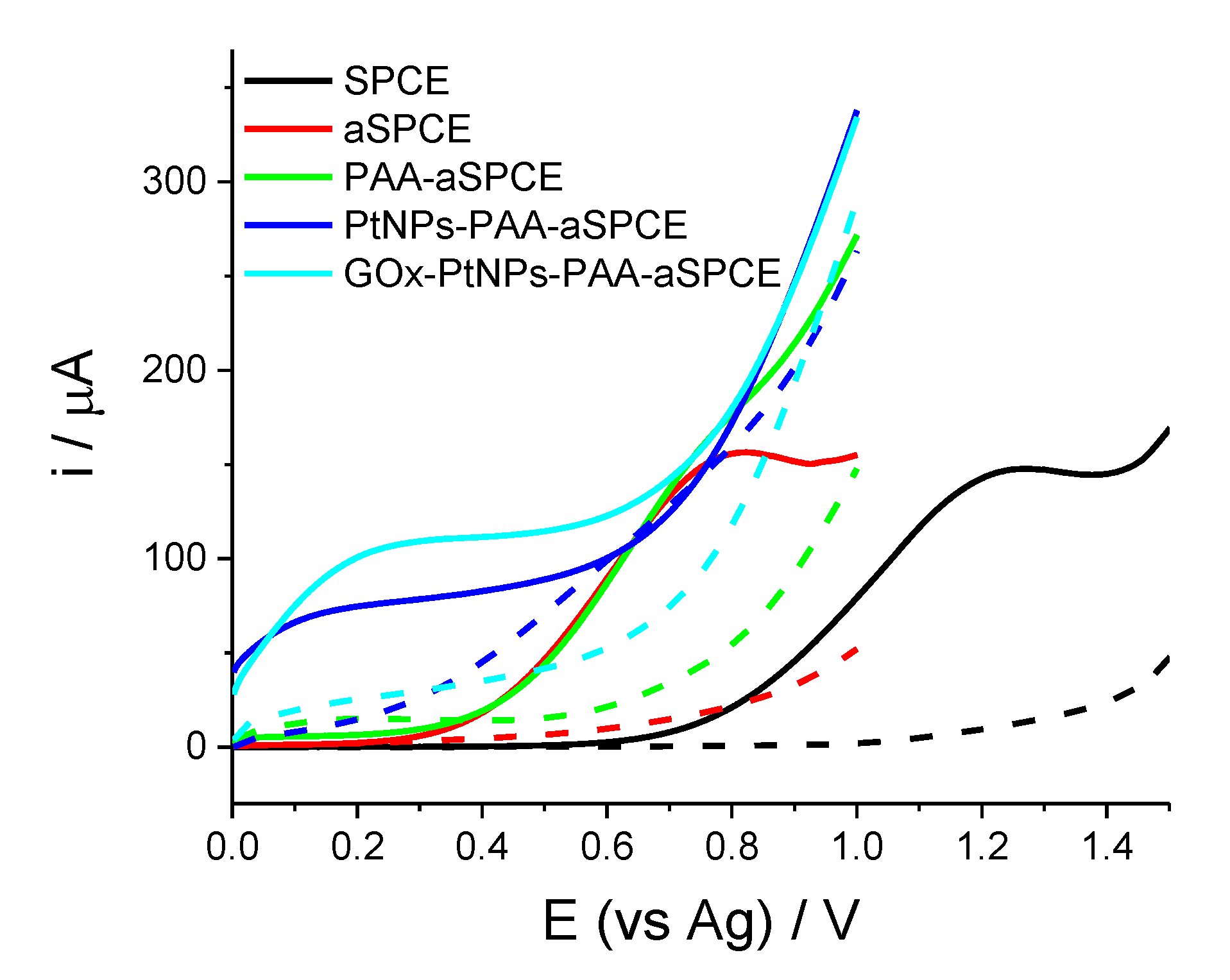
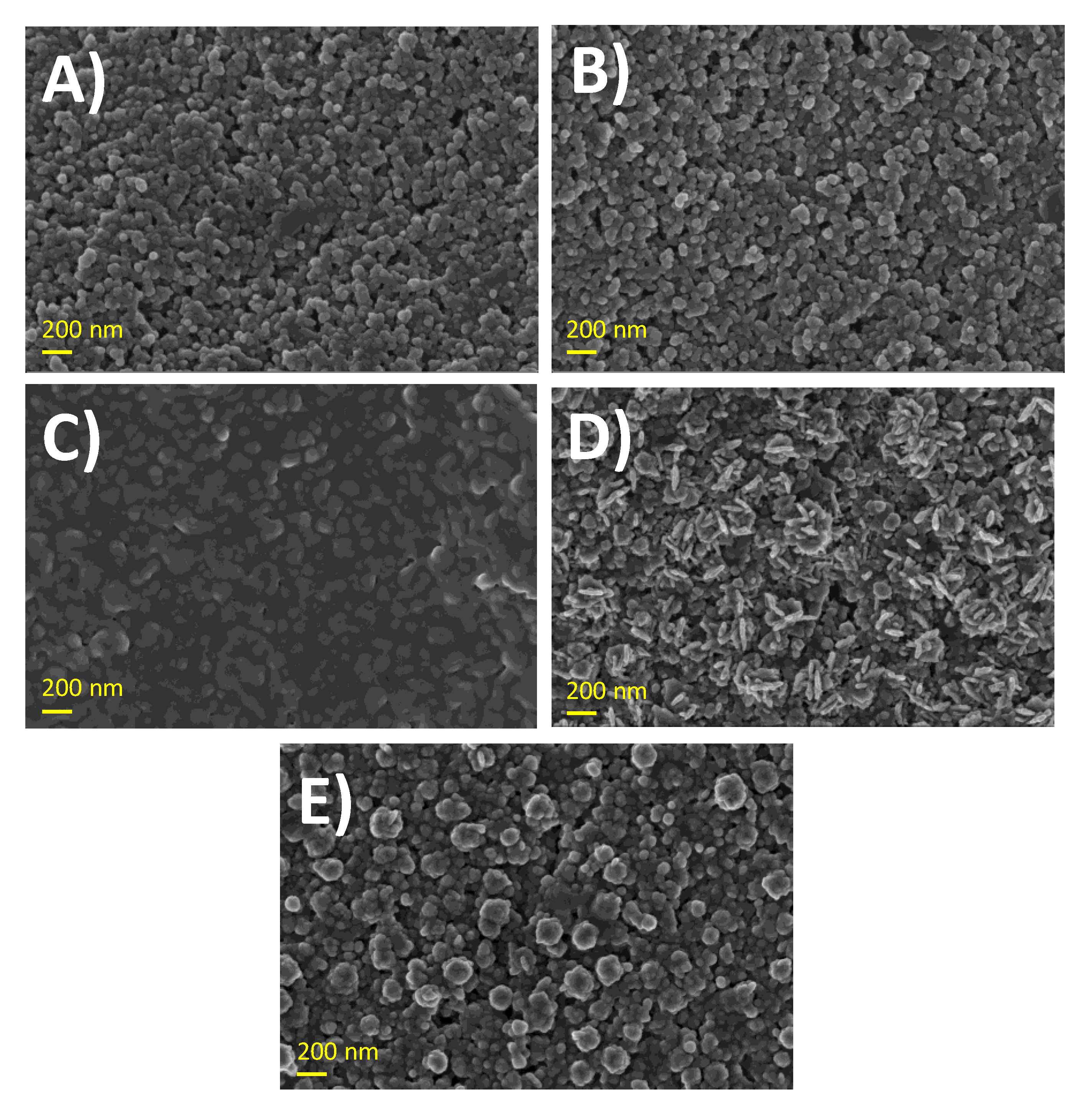
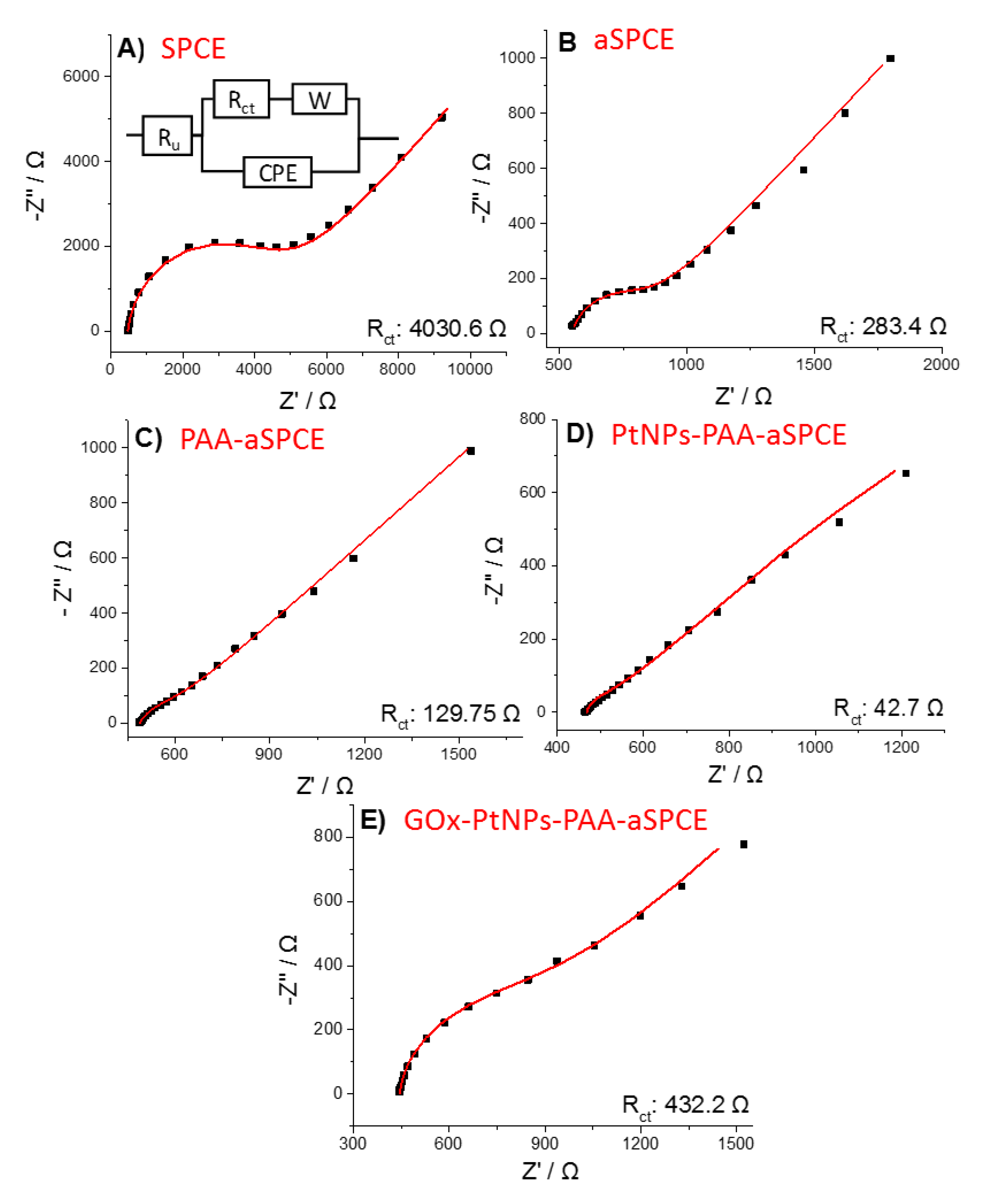
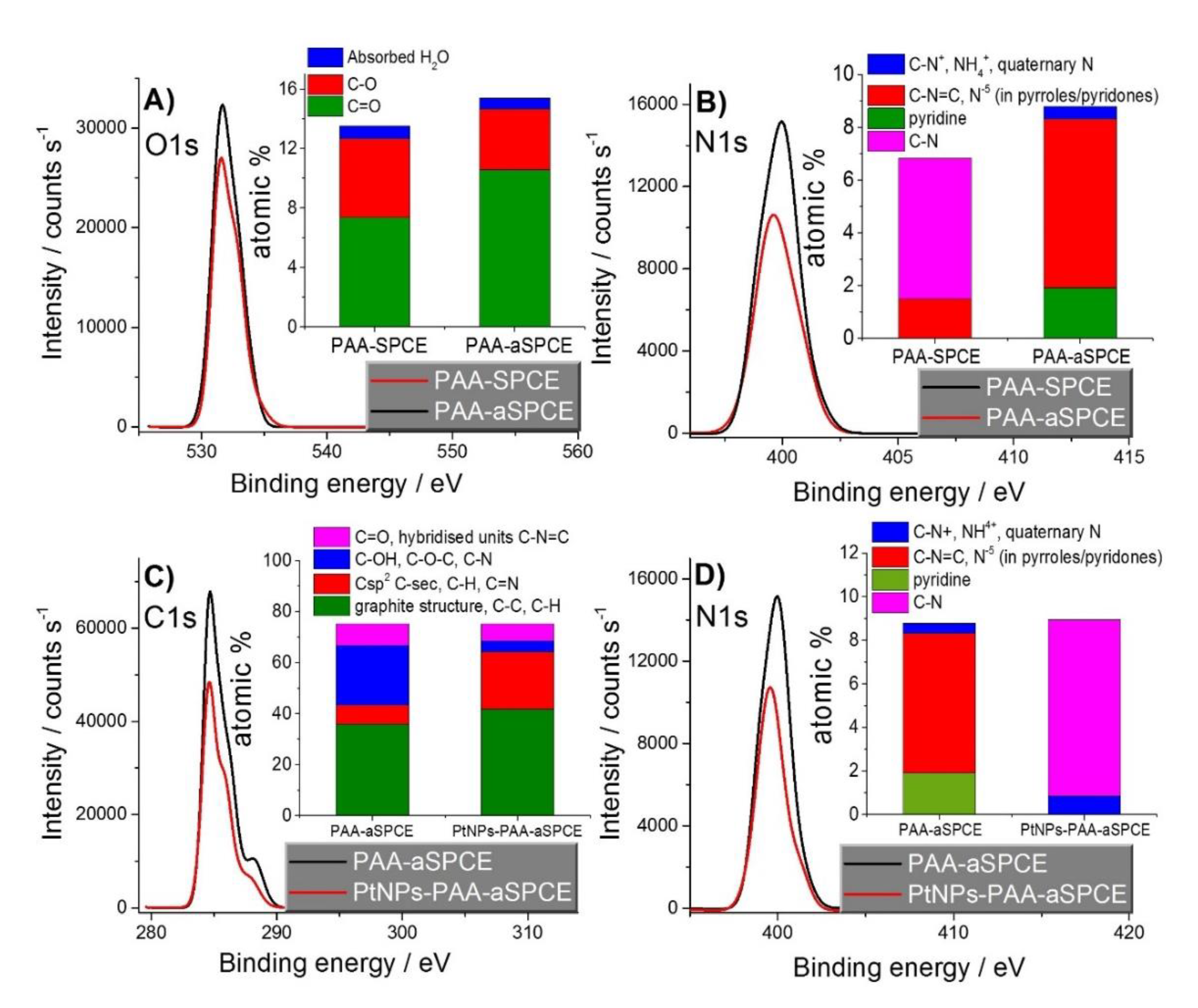
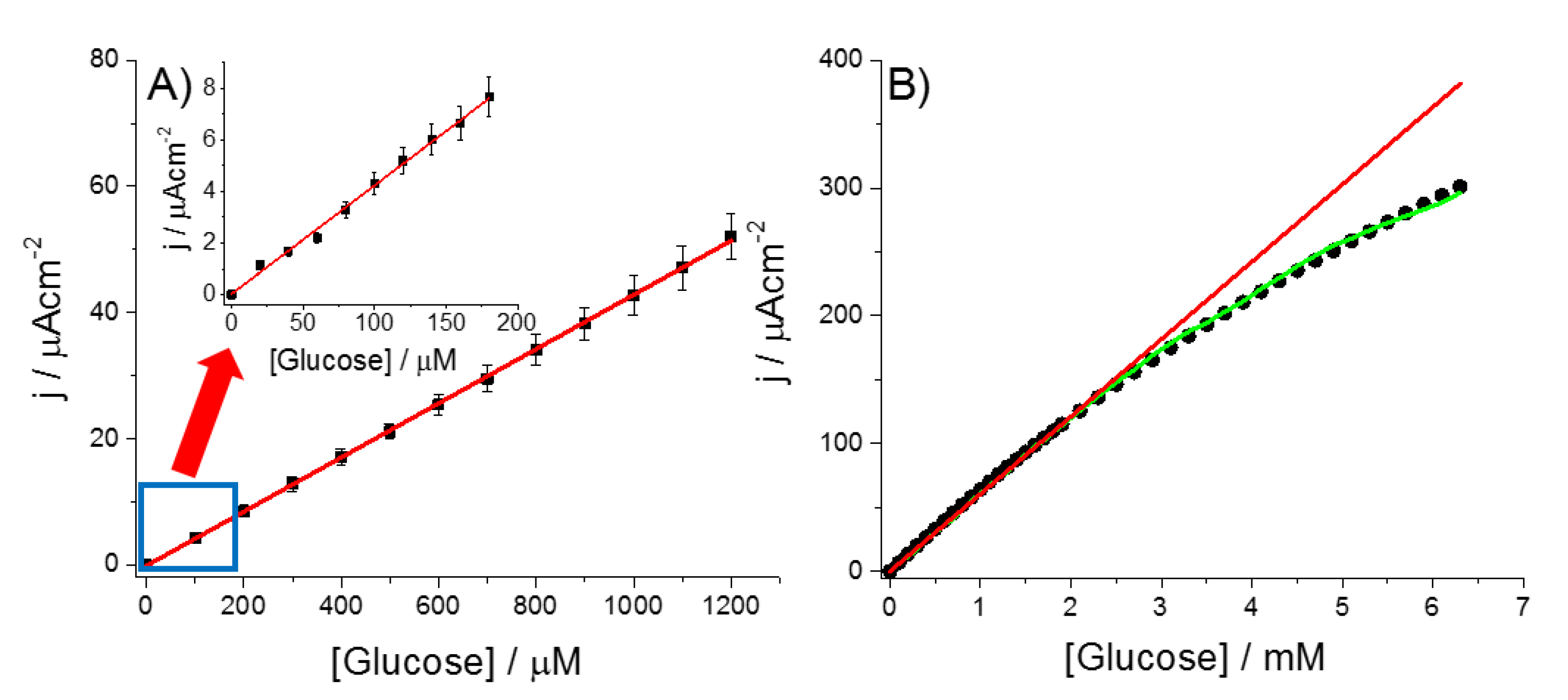
| Electrode | Potential (V) | Sensitivity (µA · mM−1 · cm−2) | LOD (µM) | Linear Range (mM) | Ref. |
|---|---|---|---|---|---|
| GOx/Fe3O4@Au/SPCE | 0.38 (vs. Ag) | 2.52 | 100.0 | 0.2–9 | [2] |
| AuNCPtNf/GOx | 0.15 (vs. Ag) | 33.66 | - | 0.01–2 | [14] |
| GOx-PoPD/PtNPs/PVF+ClO4−/Pt | 0.6 (vs. Ag/AgCl) | 17.40 | 18.0 | 0.06–9.64 | [22] |
| GOx/PtNP/PANI/Pt | 0.56 (vs. SCE) | 96.10 | 0.7 | 0.01–8 | [23] |
| MRGO/PtAuNPs/Ch-GOx/PDDA- modified hybrid electrode | 0.6 (vs. Ag/AgCl) | 17.85 | 1.0 | 0.01–8 | [35] |
| Pt/rGO/P3ABA-SPCE | 0.5 (vs. Ag) | 22.01 | 44.3 | 0.25–6 | [37] |
| GOx/Naf/MnO2-GNR/SPCE | 0.5 (vs. Ag/AgCl) | 56.32 | 50.0 | 0.1–1.4 | [38] |
| GOD/Pt/MWNT-PANI | 0.55 (vs. SCE) | 127.77 | 1.0 | 0.003–8.2 | [41] |
| PAA-VS-PANI/GPL-FePc/GOx-CH | 0.3 (vs. Ag) | 18.11 | 6.4 | 1–20 | [45] |
| GOx-GO-SH-Au-SPE | −0.55 (vs. Ag) | 3.17 | 319.4 | 3–9 | [46] |
| Paper-based maskless enzymatic sensor | −0.1 (vs. Ag) | 9.52 | 120.0 | 0.3–15 | [47] |
| Gr/PANI/AuNPs/GOx | −0.4 (vs. Ag/AgCl) | 20.32 | 100.0 | 0.2–11.2 | [48] |
| GOx-PtNPs-PAA-aSPCE | 0.2 (vs. Ag) | 42.70 | 7.6 | 0.02–2.30 | This work |
| Sample | GOx-PtNPs-PAA-aSPCE (g/100 mL) | Glucose Assay Kit (g/100 mL) | Recovery (%) |
|---|---|---|---|
| Orange juice | 1.83 ± 0.12 | 1.93 ± 0.01 | 94.8 |
| Pineapple juice | 3.96 ± 0.01 | 3.76 ± 0.18 | 105.3 |
| Peach juice | 1.14 ± 0.17 | 1.13 ± 0.06 | 100.8 |
| Gamborg’s B-5 | - | 0.07 ± 0.01 | - |
© 2020 by the authors. Licensee MDPI, Basel, Switzerland. This article is an open access article distributed under the terms and conditions of the Creative Commons Attribution (CC BY) license (http://creativecommons.org/licenses/by/4.0/).
Share and Cite
Jiménez-Fiérrez, F.; González-Sánchez, M.I.; Jiménez-Pérez, R.; Iniesta, J.; Valero, E. Glucose Biosensor Based on Disposable Activated Carbon Electrodes Modified with Platinum Nanoparticles Electrodeposited on Poly(Azure A). Sensors 2020, 20, 4489. https://doi.org/10.3390/s20164489
Jiménez-Fiérrez F, González-Sánchez MI, Jiménez-Pérez R, Iniesta J, Valero E. Glucose Biosensor Based on Disposable Activated Carbon Electrodes Modified with Platinum Nanoparticles Electrodeposited on Poly(Azure A). Sensors. 2020; 20(16):4489. https://doi.org/10.3390/s20164489
Chicago/Turabian StyleJiménez-Fiérrez, Francisco, María Isabel González-Sánchez, Rebeca Jiménez-Pérez, Jesús Iniesta, and Edelmira Valero. 2020. "Glucose Biosensor Based on Disposable Activated Carbon Electrodes Modified with Platinum Nanoparticles Electrodeposited on Poly(Azure A)" Sensors 20, no. 16: 4489. https://doi.org/10.3390/s20164489
APA StyleJiménez-Fiérrez, F., González-Sánchez, M. I., Jiménez-Pérez, R., Iniesta, J., & Valero, E. (2020). Glucose Biosensor Based on Disposable Activated Carbon Electrodes Modified with Platinum Nanoparticles Electrodeposited on Poly(Azure A). Sensors, 20(16), 4489. https://doi.org/10.3390/s20164489






